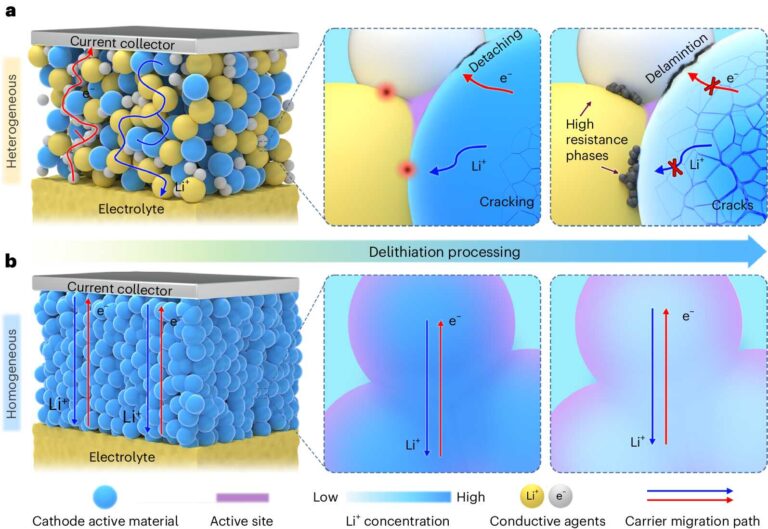Researchers at the Qingdao Institute of Bioenergy and Bioprocess Technology (QIBEBT), Chinese Academy of Sciences (CAS), in collaboration with international partners, have introduced a new cathode homogenization strategy for all-solid-state lithium batteries (ASLBs).
This approach, detailed in a recent Nature Energy publication, is designed to enhance the cycle life and energy density of ASLBs.
The team addressed a key challenge in ASLBs: the use of heterogeneous composite cathodes, which rely on electrochemically inactive additives to improve conduction. These additives can reduce the battery’s energy density and shorten its cycle life due to their incompatibility with layered oxide cathodes, which undergo substantial volume changes during operation.
To tackle this issue, the researchers developed a strategy that utilizes a zero-strain material, Li1.75Ti2(Ge0.25P0.75S3.8Se0.2)3 (LTG0.25PSSe0.2). This material provides excellent mixed ionic and electronic conductivity, allowing for efficient charge transport throughout the charge-discharge process without the need for additional conductive additives.
Prof. Ju Jiangwei, co-corresponding author of the study from the Solid Energy System Technology Center (SERGY) at QIBEBT, commented, “The material’s stability and performance metrics are impressive, making it a strong candidate for commercial applications in electric vehicles and large-scale energy storage systems.”
The LTG0.25PSSe0.2 material has shown impressive results, including a specific capacity of 250mAh g–1 and minimal volume change of 1.2%. A homogeneous cathode made entirely of this material enables ASLBs to operate stably for over 20,000 cycles at room temperature, with a high energy density of 390Wh kg−1 at the cell level.
SERGY’s Dr Cui Longfei, co-first author of the study, noted that this cathode homogenization strategy challenges conventional designs by eliminating inactive additives: “By eliminating the need for inactive additives, we enhance energy density and extend the battery’s cycle life.”
Extensive testing and theoretical calculations have confirmed the electrochemical and mechanical stability of these homogeneous cathodes, showing no adverse chemical reactions or significant resistance increases after prolonged use, according to the researchers.
The implications of this research extend beyond ASLBs. Other battery technologies, such as solid-state sodium batteries, lithium-ion batteries, lithium-sulfur batteries, sodium-ion batteries and fuel cells, also face challenges related to heterogeneous electrodes, which this strategy may help to address.
The research team plans to further explore the scalability of the LTG0.25PSSe0.2 material and its integration into practical battery systems, with the potential for commercialization in electric vehicles and large-scale energy storage applications. This advance lays the groundwork for future innovations in energy storage technology.
Prof. Cui Guanglei, head of SERGY, said, “Our universal strategy for designing multifunctional homogeneous cathodes can overcome the energy, power and lifespan barriers in energy storage, paving the way for real-world applications.”


